Comparative Design and Performance Analysis of 10 kW Rare-Earth and Non-Rare Earth Flux Reversal Wind Generators
Abstract
:1. Introduction
2. Design Sizing and Analytical Formulation
2.1. Basic Structure and FEA Model Formulation
2.2. DQ-Axes Modelling
3. Generators Performance Evaluation
3.1. No-Load Analysis
3.2. On-Load Analysis
3.3. Mass and Cost Estimation
3.4. Demagnetization Risks
4. Conclusions
Author Contributions
Funding
Institutional Review Board Statement
Informed Consent Statement
Data Availability Statement
Conflicts of Interest
References
- REN 21. Renewables 2020 Global Status Report (Paris: REN21 Secretariat). Available online: http://www.ren21.net/gsr (accessed on 10 October 2020).
- Potgieter, J.H.J.; Kamper, M.J. Double PM-Rotor, Toothed, Toroidal-Winding Wind Generator: A Comparison with Conventional Winding Direct-Drive PM Wind Generators Over a Wide Power Range. IEEE Trans. Ind. Appl. 2016, 52, 2881–2891. [Google Scholar] [CrossRef]
- Polinder, H.; van der Pijl, F.F.A.; de Vilder, G.J.; Tavner, P. Comparison of direct-drive and geared generator concepts for wind turbines. IEEE Trans. Energy Convers. 2006, 21, 725–733. [Google Scholar] [CrossRef] [Green Version]
- Ojeda, J.; Simoes, M.G.; Li, G.; Gabsi, M. Design of a flux-switching electrical generator for wind turbine systems. IEEE Trans. Ind. Appl. 2012, 48, 1808–1816. [Google Scholar] [CrossRef]
- Akuru, U.B.; Kamper, M.J. Optimisation and Design Comparison of 10 kW and 3 MW PM Flux Switching Machines for Geared Medium-Speed Wind Power Generators. Electr. Eng. 2018, 100, 2509–2525. [Google Scholar] [CrossRef]
- Shao, L.; Hua, W.; Soulard, J.; Zhu, Z.; Wu, Z.; Cheng, M. Electromagnetic Performance Comparison Between 12-Phase Switched Flux and Surface-Mounted PM Machines for Direct-Drive Wind Power Generation. IEEE Trans. Ind. Appl. 2020, 56, 1408–1422. [Google Scholar] [CrossRef]
- Zhao, Y.; Kou, B.; Zhao, X. A Study of Torque Characteristics of a Novel Flux Reversal Machine. In Proceedings of the 22nd International Conference on Electrical Machines and Systems (ICEMS), Harbin, China, 11–14 August 2019; pp. 1–5. [Google Scholar]
- Gao, Y.; Qu, R.; Li, D.; Li, J. Torque Performance Analysis of Three-Phase Flux Reversal Machines. IEEE Trans. Ind. Appl. 2017, 53, 2110–2119. [Google Scholar] [CrossRef]
- Gao, Y.; Li, D.; Qu, R.; Ding, H. Synthesis of Novel Flux Modulation Machine with Permanent Magnets on Both Stator and Rotor. In Proceedings of the IEEE International Electric Machines & Drives Conference (IEMDC), San Diego, CA, USA, 12–15 May 2019; pp. 678–685. [Google Scholar]
- Zhang, J.; Cheng, M.; Hua, W.; Zhu, X. New approach to power equation for comparison of doubly salient electrical machines. In Proceedings of the IEEE Industry Applications Annual Meeting, Tampa, FL, USA, 8–12 October 2006; pp. 1178–1185. [Google Scholar]
- Tahanian, H.; Aliahmadi, M.; Faiz, J. Ferrite Permanent Magnets in Electrical Machines: Opportunities and Challenges of a Non-Rare-Earth Alternative. IEEE Trans. Magn. 2020, 56, 1–20. [Google Scholar] [CrossRef]
- Shin, H.K.; Kim, T.H. A Study on the Iron Loss and Demagnetization Characteristics of an Inset-type Flux-Reversal Machine. J. Magn. 2013, 18, 297–301. [Google Scholar]
- Deodhar, R.P.; Andersson, S.; Boldea, I.; Miller, T.J.E. The flux reversal machine: A new doubly salient permanent magnet machine. IEEE Trans. Ind. Appl. 1997, 33, 925–934. [Google Scholar] [CrossRef]
- Ghasemian, M.; Tahami, F.; Rezazadeh, G. A comparative analysis of permanent magnet flux reversal generators with distributed and concentrated winding. In Proceedings of the IECON-43rd Annual Conference of the IEEE Industrial Electronics Society, Beijing, China, 29 October–1 November 2017; pp. 1657–1661. [Google Scholar]
- Sharma, A.; Sashidhar, S. A Novel Ring Permanent Magnet Flux Reversal Machine for a Direct-Drive Wind Generator. In Proceedings of the IECON the 46th Annual Conference of the IEEE Industrial Electronics Society, Singapore, 18–21 October 2020; pp. 838–843. [Google Scholar]
- More, D.S.; Kalluru, H.; Fernandes, B.G. Outer rotor flux reversal machine for rooftop wind generator. In Proceedings of the 2008 IEEE Industry Applications Society Annual Meeting, Edmonton, AB, Canada, 5–9 October 2008; pp. 1–6. [Google Scholar]
- Dmitrievskii, V.A.; Prakht, V.A.; Kazakbaev, V.M. Design and Mathematical Modeling of Gearless SMC Flux Reversal Generator for Wind Turbine. In Proceedings of the XIII International Conference on Electrical Machines (ICEM), Alexandroupoli, Greece, 3–6 September 2018; pp. 2079–2084. [Google Scholar]
- Lee, C.H.T.; Chau, K.T.; Liu, C. Design and analysis of a cost-effective magnetless multiphase flux-reversal DC-field machine for wind power generation. IEEE Trans. Energy Convers. 2015, 30, 1565–1573. [Google Scholar] [CrossRef] [Green Version]
- Pavel, C.C.; Lacal-Arántegui, R.; Marmier, A.; Schüler, D.; Tzimas, E.; Buchert, M.; Jenseit, W.; Blagoeva, D. Substitution strategies for reducing the use of rare earths in wind turbines. Resour. Policy 2017, 52, 349–357. [Google Scholar] [CrossRef]
- Akuru, U.B.; Kamper, M.J. Intriguing Behavioral Characteristics of Rare-Earth-Free Flux Switching Wind Generators at Small- and Large-Scale Power Level. IEEE Trans. Ind. Appl. 2018, 54, 5772–5782. [Google Scholar] [CrossRef]
- Szabó, L. A Survey on Modular Variable Reluctance Generators for Small Wind Turbines. IEEE Trans. Ind. Appl. 2019, 55, 2548–2557. [Google Scholar] [CrossRef]
- Shrestha, G.; Polinder, H.; Ferreira, J.A. Scaling laws for direct drive generators in wind turbines. In Proceedings of the 2009 IEEE International Electric Machines and Drives Conference, Miami, FL, USA, 3–6 May 2009; pp. 797–803. [Google Scholar]
- Boldea, I.; Wang, C.; Nasar, S.A. Design of a three-phase flux reversal machine. Electr. Mach. Power Syst. 1999, 27, 849–863. [Google Scholar]
- Boldea, I.; Zhang, J.; Naser, S.A. Theoretical characterization of flux reversal machine in low-speed servo drives-the pole-PM configuration. IEEE Trans. Ind. Appl. 2002, 37, 1549–1556. [Google Scholar] [CrossRef]
- Akuru, U.B.; Kamper, M.J. Formulation and Multi-objective Design Optimization of Wound-Field Flux Switching Machines for Wind Energy Drives. IEEE Trans. Ind. Electron. 2018, 65, 1828–1836. [Google Scholar] [CrossRef]
- Manne, B.; Malligunta, K.K.; Akuru, U.B. Design and Performance Assessment of a Small-Scale Ferrite-PM Flux Reversal Wind Generator. Energies 2020, 24, 5565. [Google Scholar] [CrossRef]
- Akuru, U.B. An Overview on Cogging Torque and Torque Ripple Reduction in Flux Switching Machines. Int. J. Energy Power Syst. (IJPES) 2021, 41, 130–144. [Google Scholar] [CrossRef]
- Prakht, V.; Dmitrievskii, V.; Kazakbaev, V.; Ibrahim, M.N. Comparison between rare-earth and ferrite permanent magnet flux-switching generators for gearless wind turbines. In Proceedings of the 7th International Conference on Power and Energy Systems Engineering, CPESE, Fukuoka, Japan, 26–29 September 2020. [Google Scholar]
- Akuru, U.B.; Kamper, M.J. Design and Investigation of Low-cost PM Flux Switching Machine for Geared Medium-speed Wind Energy Applications. Electr. Power Compon. Syst. 2018, 46, 1084–1092. [Google Scholar] [CrossRef]
- Liu, D.; Song, X.; Wang, X. Design Challenges of Direct-Drive Permanent Magnet Superconducting Wind Turbine Generators. In Proceedings of the International Conference on Electrical Machines (ICEM), Gothenburg, Sweden, 23–26 August 2020; pp. 640–646. [Google Scholar]
- Zhang, K.; Huang, X.; Wu, L.; Fang, Y.; Cao, W. Stator Design Aspects for Permanent Magnet Superconducting Wind Power Generators. IEEE Trans. Appl. Supercond. 2019, 29, 1–5. [Google Scholar] [CrossRef]
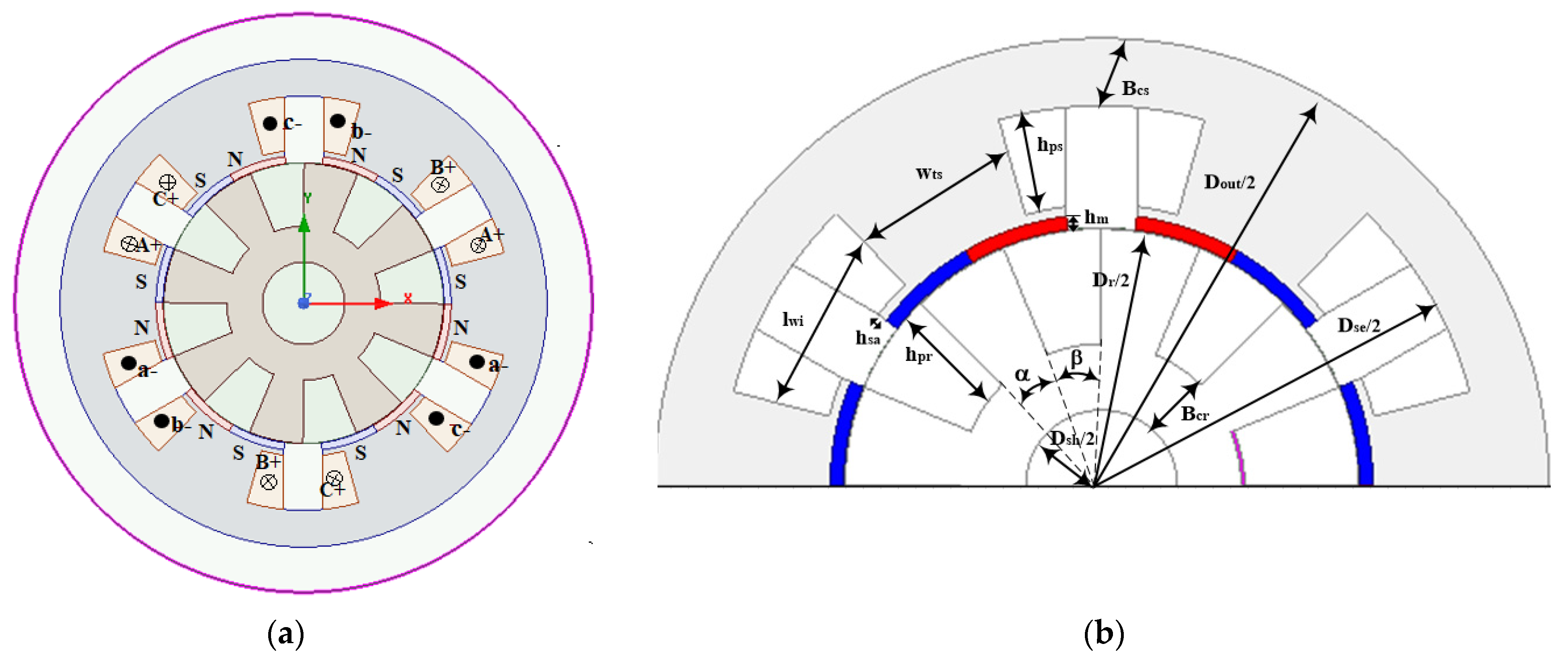
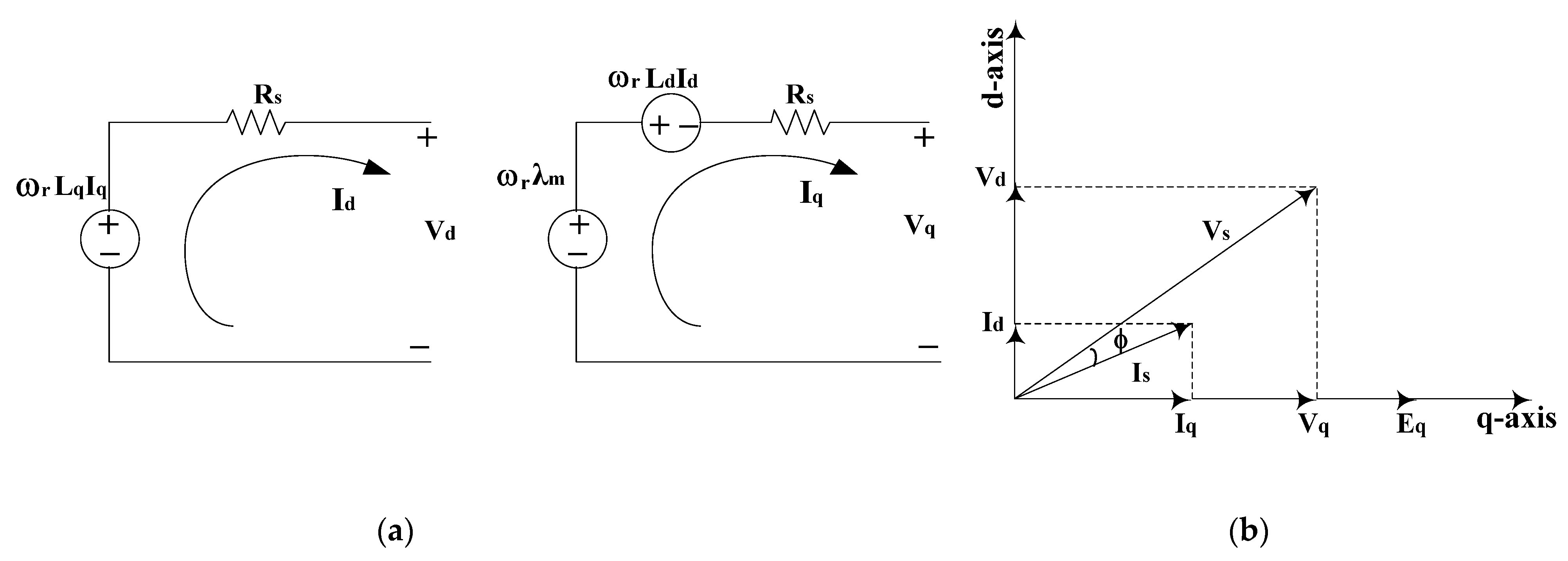
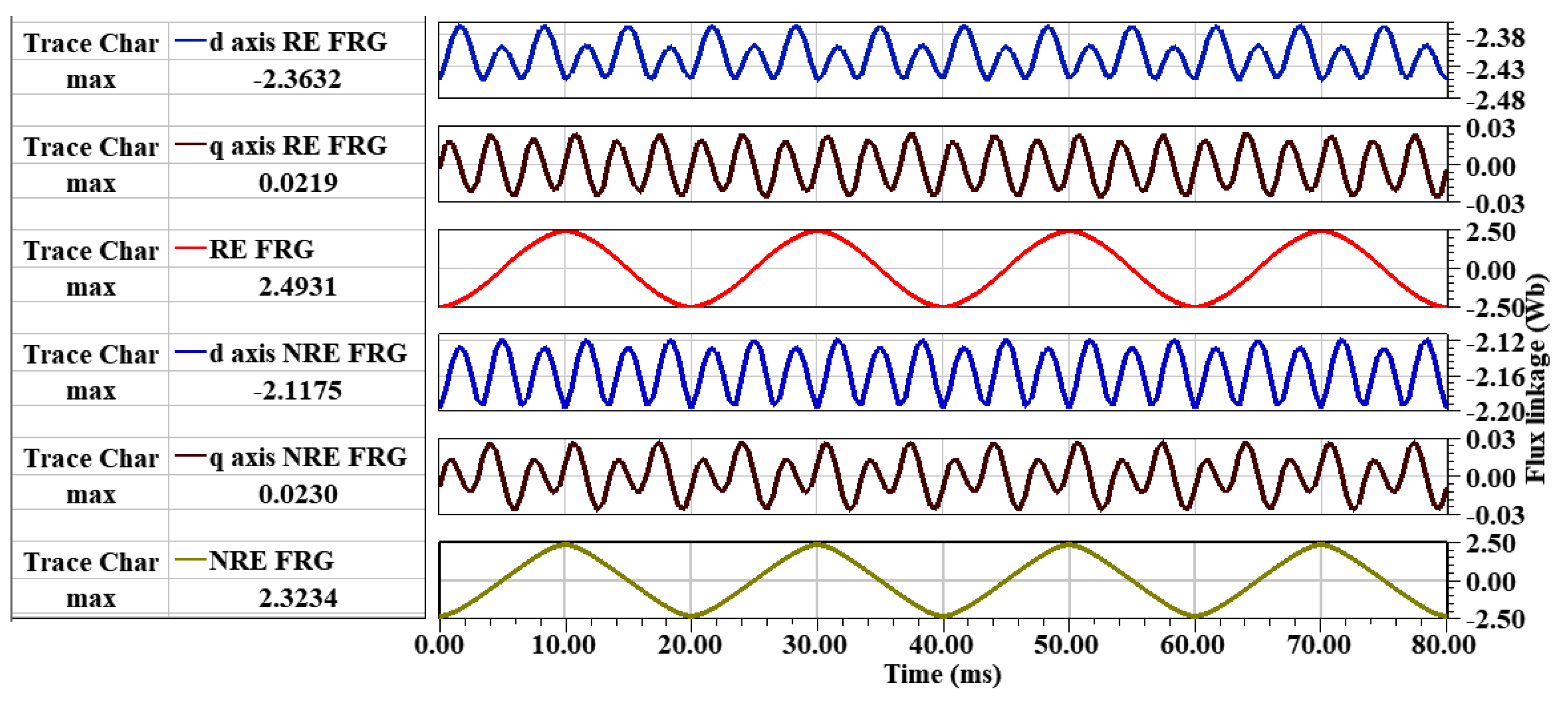

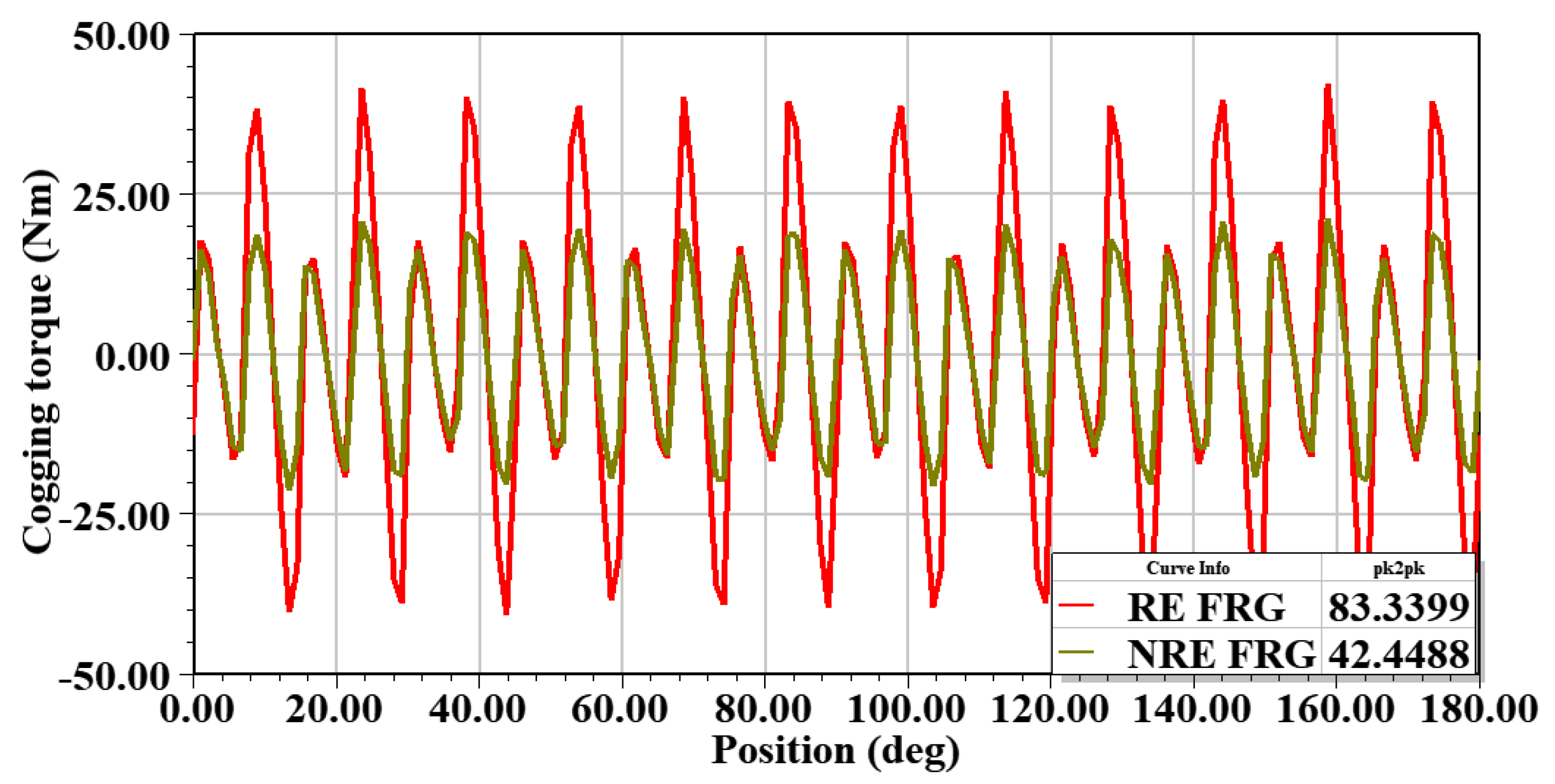
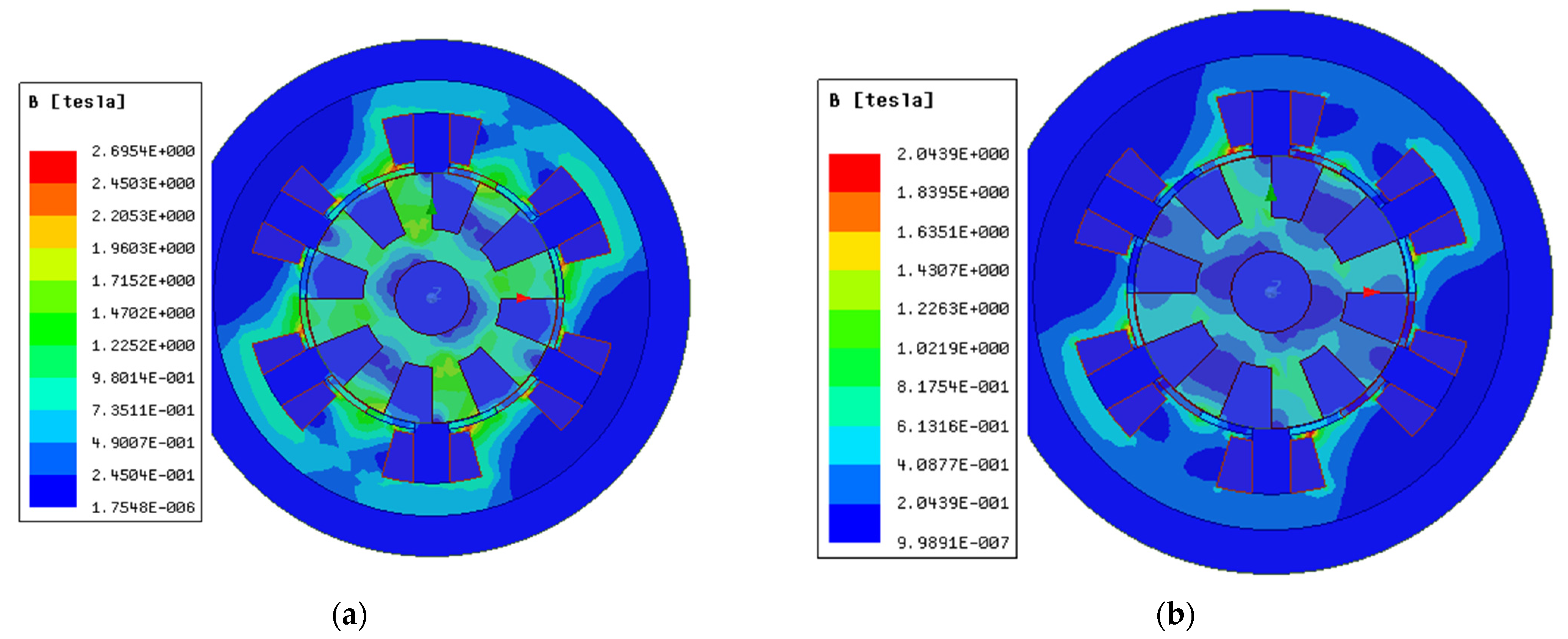
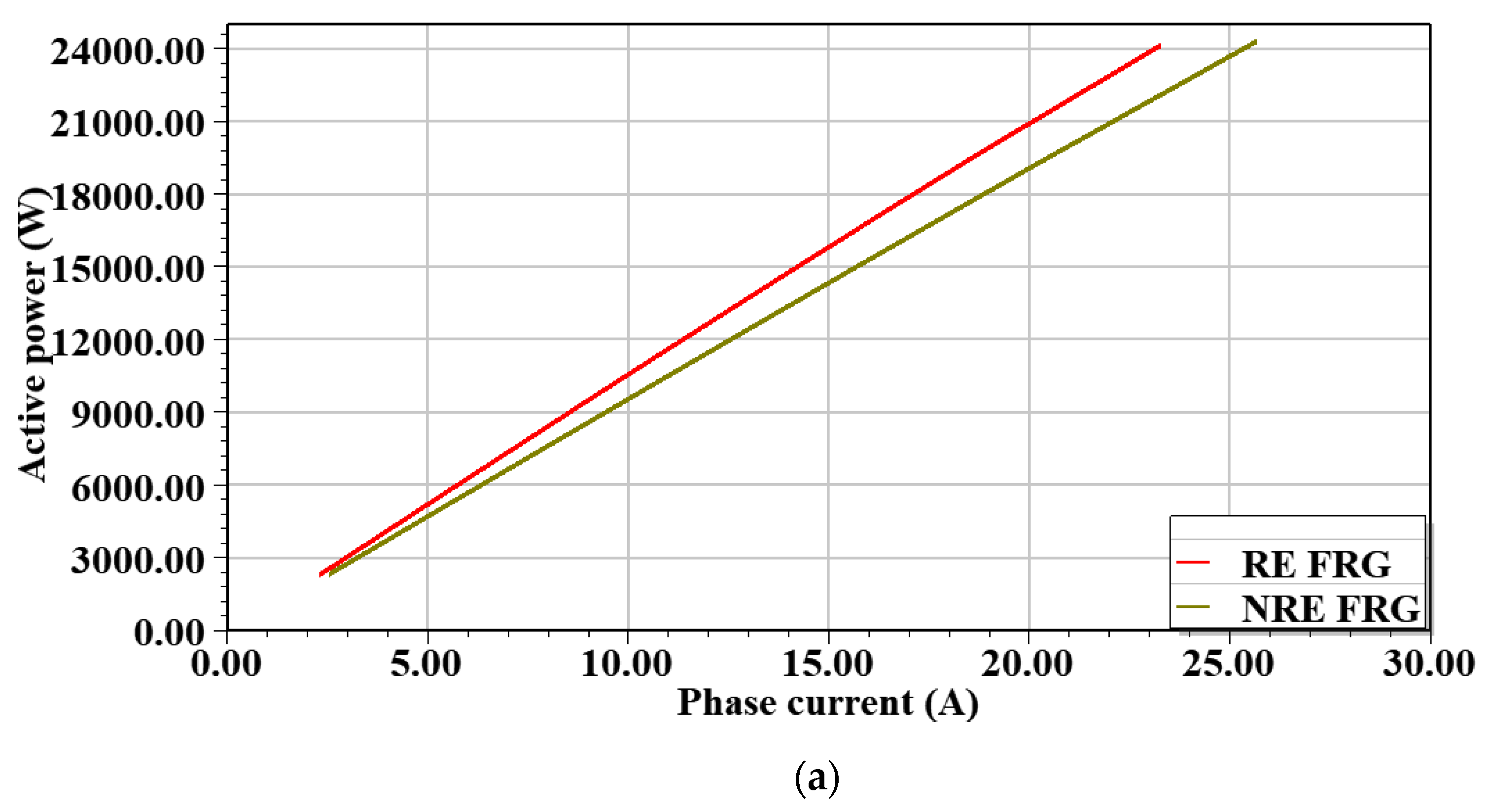
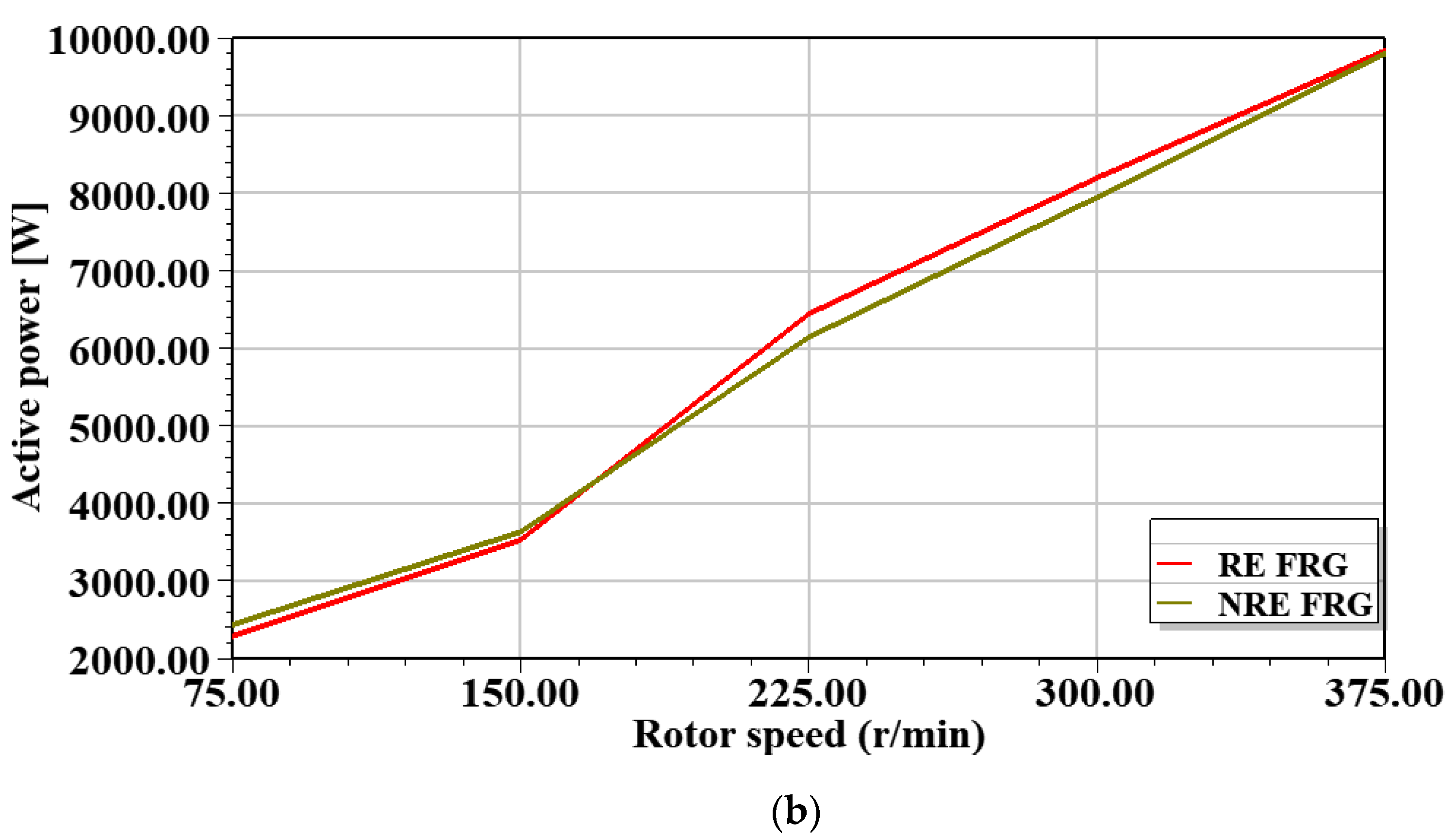
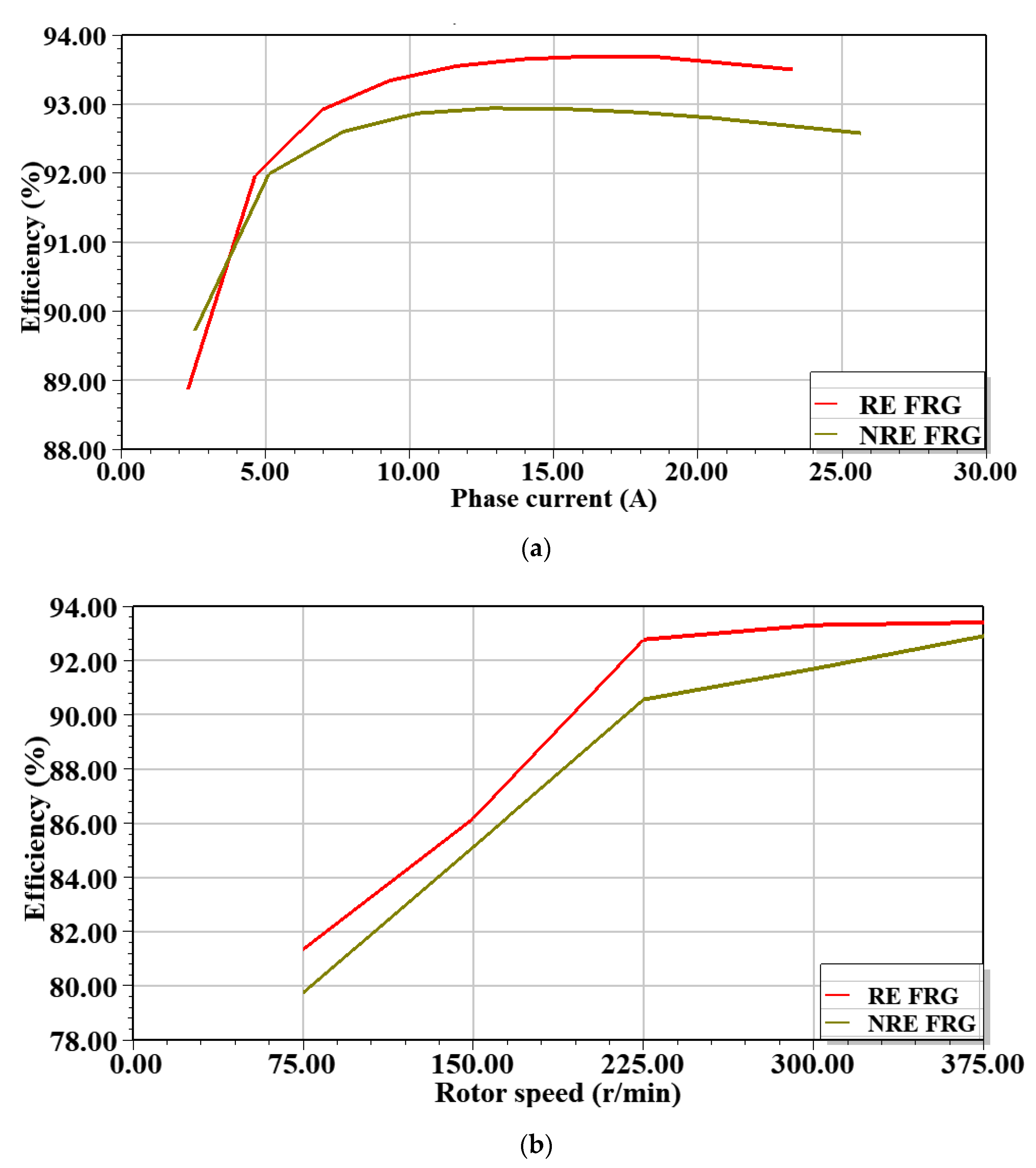
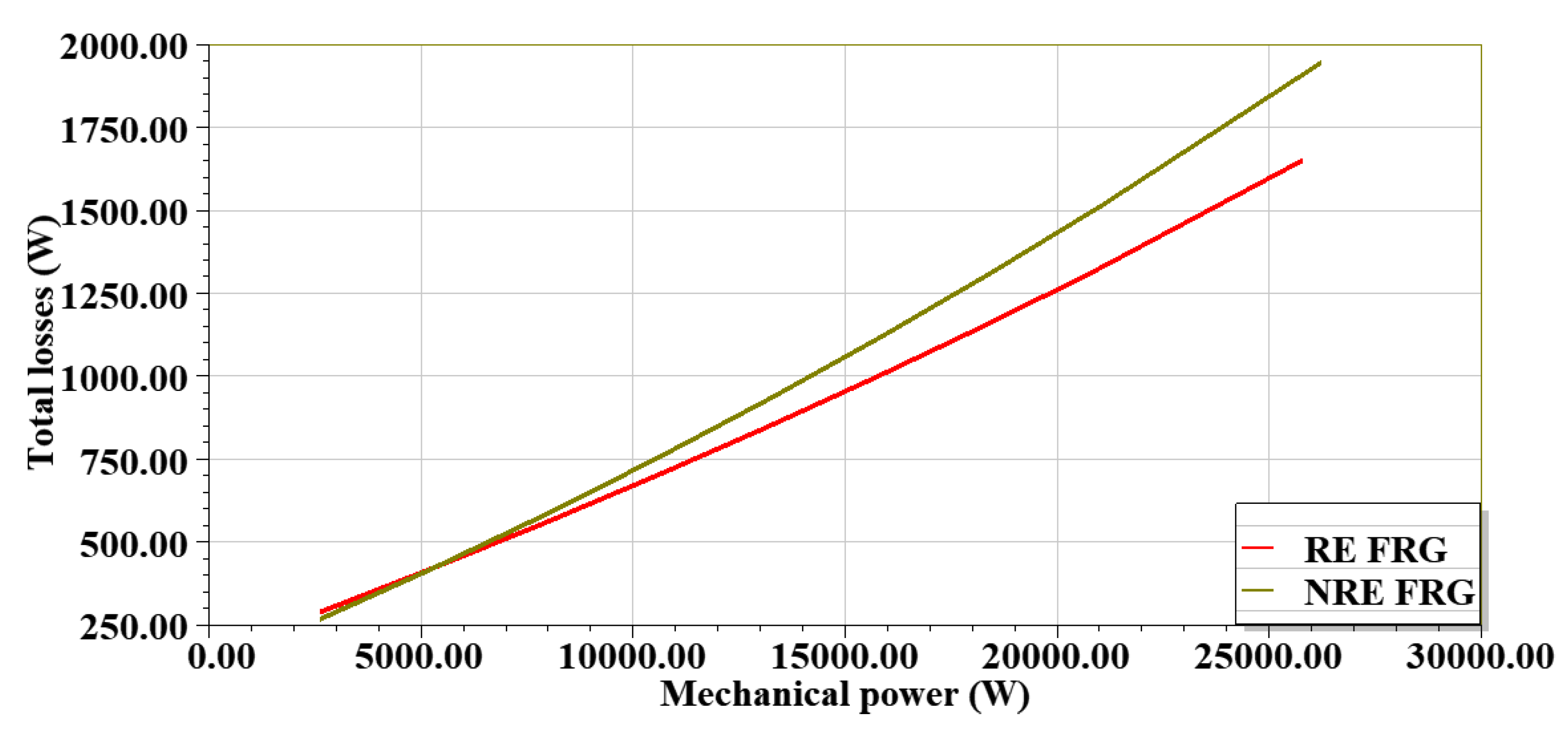
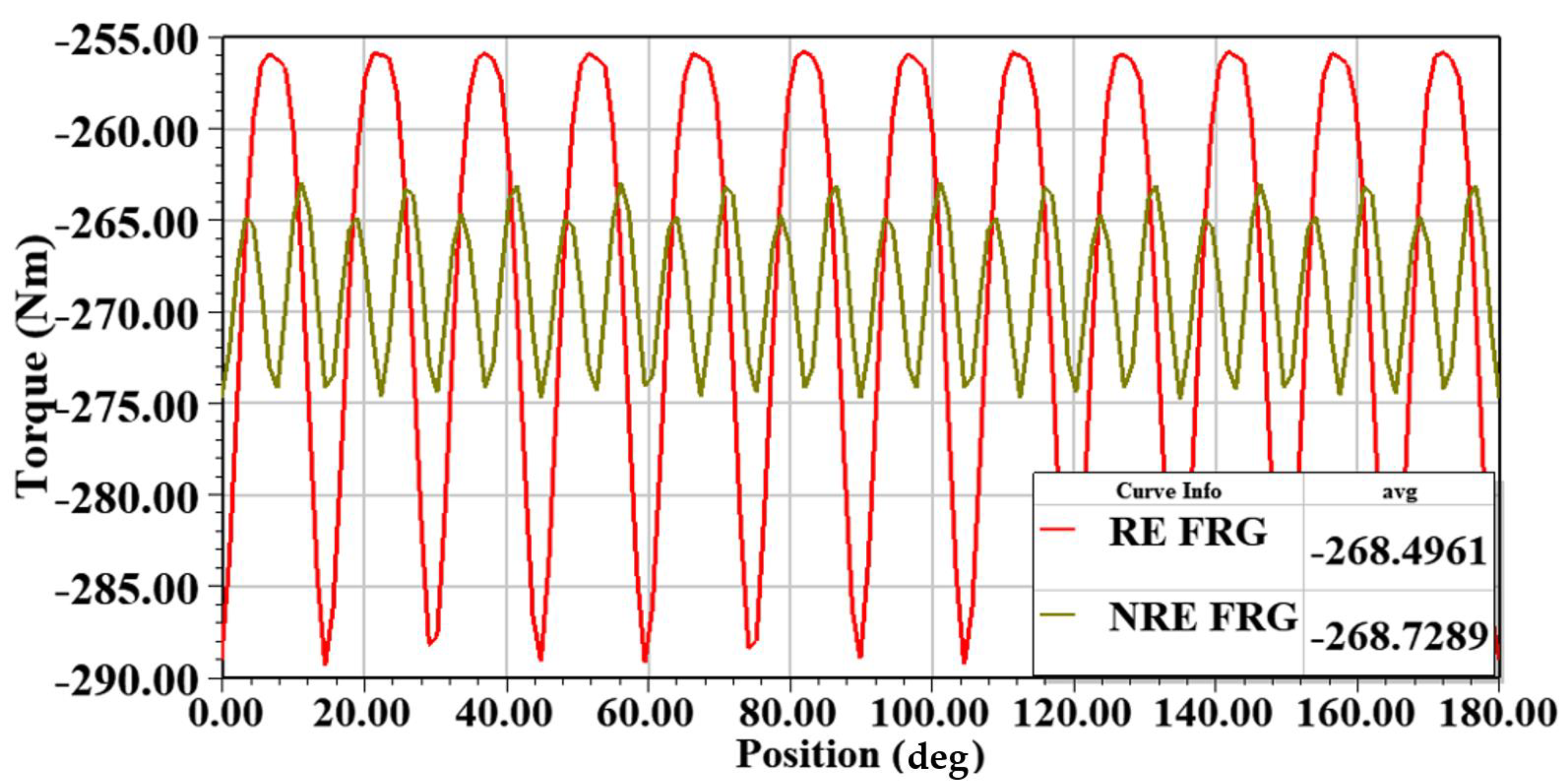
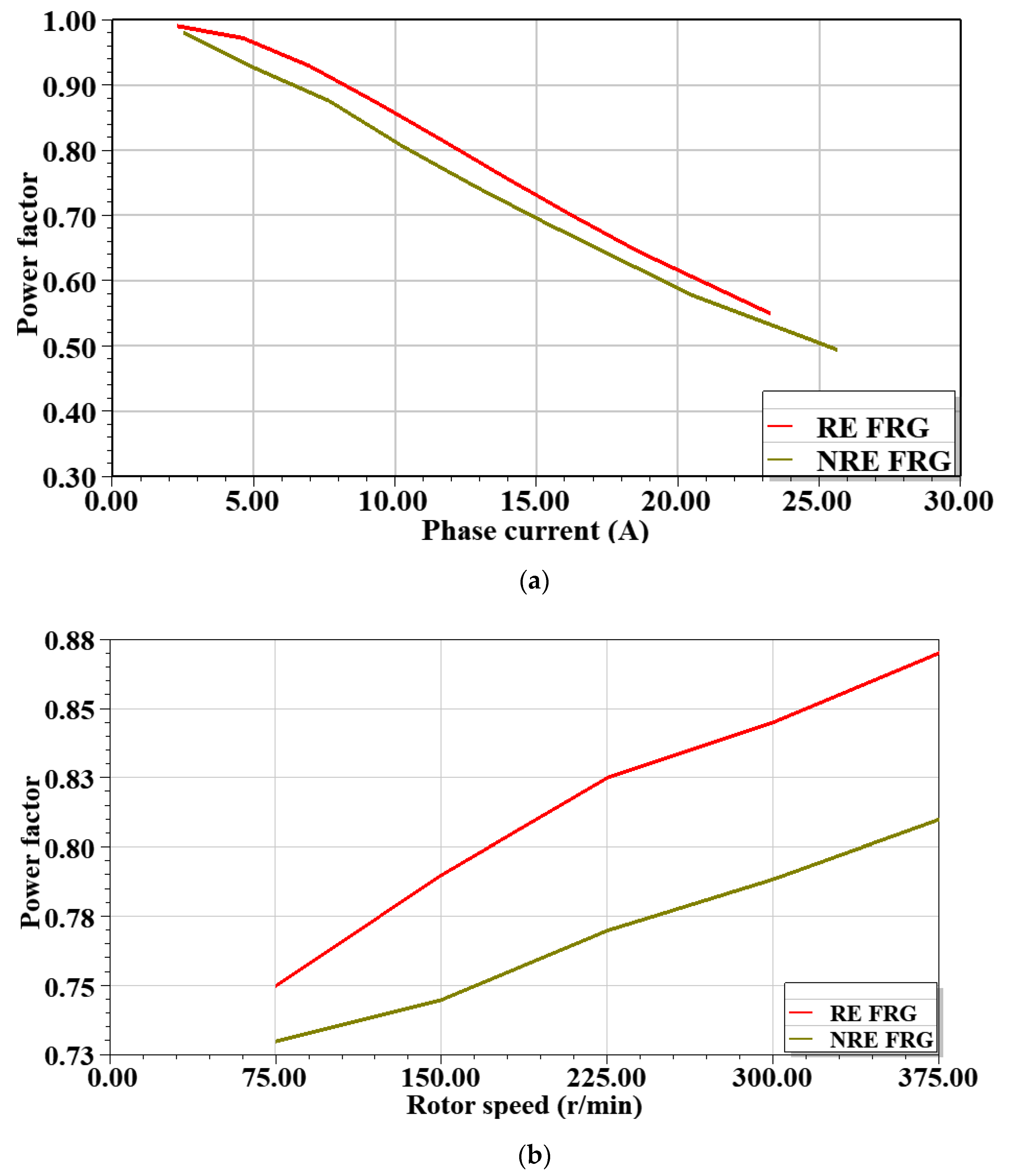

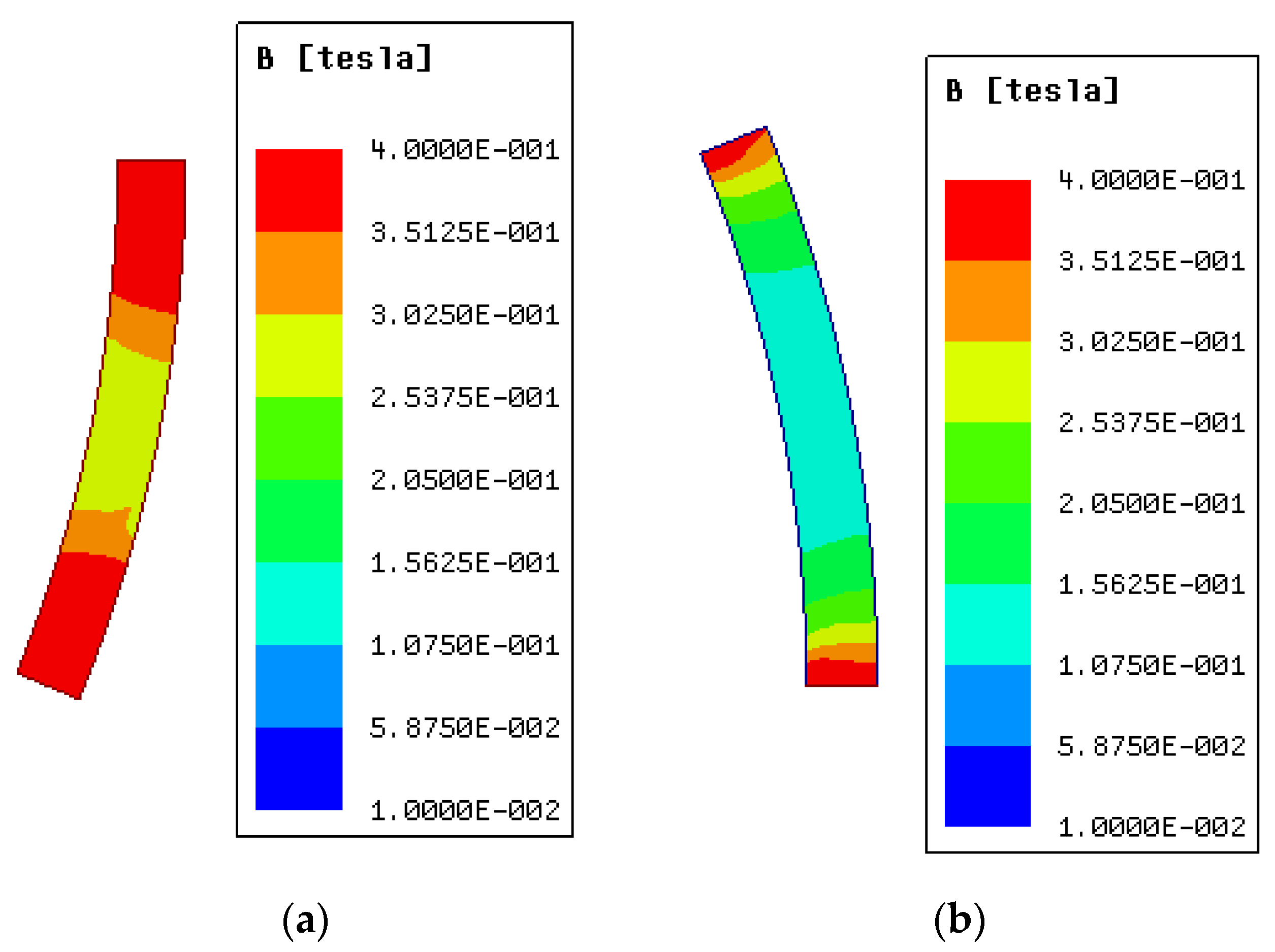
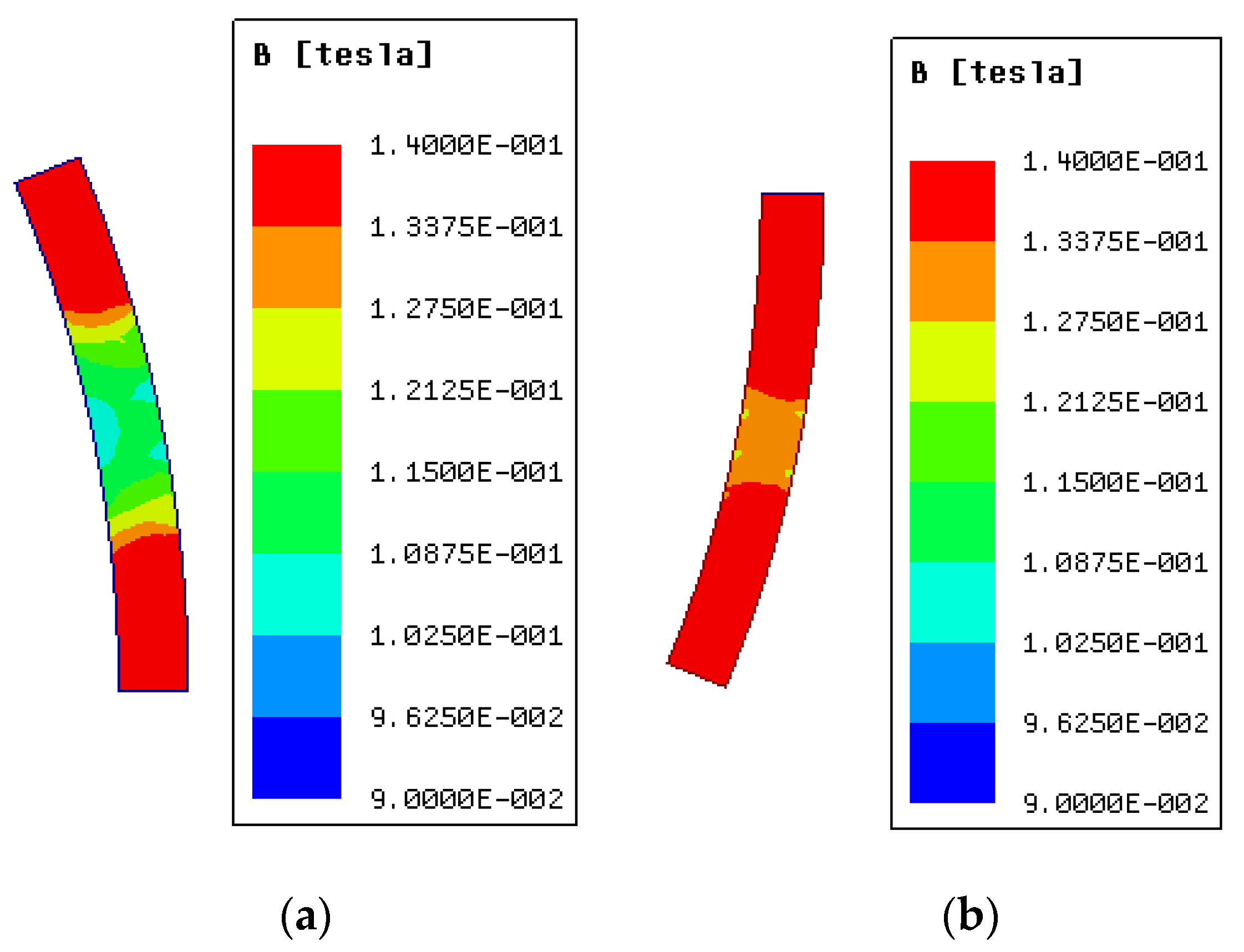
| Parameter/Dimension | RE-FRG | NRE-FRG |
|---|---|---|
| Stator outer diameter (), mm | 253 | 272 |
| Number turns per coil () | 80 | 80 |
| Stack length (), mm | 165 | 280 |
| Airgap (g), mm | 0.5 | 0.5 |
| Magnet thickness (), mm | 4 | 8 |
| Outer rotor diameter (), mm | 156 | 165 |
| Rotor pole span angle (α = β), deg | 22.5 | 22.5 |
| Rotor pole height (), mm | 44 | 52 |
| Stator pole width (), mm | 57 | 71 |
| Slot opening width (), mm | 70 | 92 |
| Stator back iron thickness (), mm | 11 | 24 |
| Shaft diameter (), mm | 46 | 46 |
| Current density (J), () | 5 | 5 |
| Rated speed (), (r/min) | 375 | 375 |
| Fill factor () | 0.4 | 0.4 |
| Rated frequency (), (Hz) | 50 | 50 |
| Parameter | RE-FRG | NRE-FRG |
|---|---|---|
| Output real electrical power at rated load condition (W) | 9840.9 | 9806.3 |
| Input electromechanical power at rated condition (W) (375 r/min, torque 268.4 Nm) | 10,542 | 10,558 |
| Required AC-DC converter power VA | 11,277 | 12,256 |
| Torque ripple under half-rated load, % | 7.26 | 4.19 |
| Torque ripple under rated load, % | 12.46 | 4.4 |
| Torque ripple, % | 9.86 | 4.29 |
| Efficiency at normal load (0.5 times of rated load), % | 91.9 | 92 |
| Efficiency at rated load, % | 93.4 | 92.9 |
| Average efficiency, % | 92.7 | 92.4 |
| Total losses at rated load, W | 701.4 | 753.8 |
| Power factor | 0.87 | 0.81 |
| Cost (USD/kg) | |
|---|---|
| Steel laminations | 1 |
| Copper | 7 |
| Sr-Fe (Ferrites) | 18.46 |
| Nd-Fe35 (Rare earths) | 126.6 |
| Parameter | RE-FRG | NRE-FRG |
|---|---|---|
| Mass of the stator core, kg | 58.16 | 160.9 |
| Mass of the rotor core, kg | 23.82 | 59.89 |
| Mass of the magnets, kg | 3.12 | 8.47 |
| Mass of the copper, kg | 14.6 | 29.77 |
| Mass of the total machine, kg | 99.7 | 259.01 |
| Torque density (kNm/) | 32.356 | 16.515 |
| Torque/PM mass (Nm/kg) | 86.1 | 31.727 |
| Torque/Active mass (Nm/kg) | 2.693 | 1.04 |
| Active material cost, $ | 579.2 | 585.5 |
| Rare Earth | Ferrites | |
|---|---|---|
| Grade | N35SH | Y32 |
| Relative permeability () | 1.09 | 1.09 |
| Remanent flux density (), T | 1.2 | 0.4 |
| Coercive force () kA/m; | 900 | 300 |
| Mass density D, kg/ | 7500 | 5000 |
| Temperature coefficients (), % | −0.12 | −0.2 |
| Temperature coefficients (), % | −0.55 | 0.40 |
| Laminations | Electrical steel: steel_1008 | Electrical steel: steel_1008 |
| Stator windings | Copper: = 2.1 × Ωm | Copper: = 2.1 × Ωm |
Publisher’s Note: MDPI stays neutral with regard to jurisdictional claims in published maps and institutional affiliations. |
© 2022 by the authors. Licensee MDPI, Basel, Switzerland. This article is an open access article distributed under the terms and conditions of the Creative Commons Attribution (CC BY) license (https://creativecommons.org/licenses/by/4.0/).
Share and Cite
Bharathi, M.; Akuru, U.B.; Kumar, M.K. Comparative Design and Performance Analysis of 10 kW Rare-Earth and Non-Rare Earth Flux Reversal Wind Generators. Energies 2022, 15, 636. https://doi.org/10.3390/en15020636
Bharathi M, Akuru UB, Kumar MK. Comparative Design and Performance Analysis of 10 kW Rare-Earth and Non-Rare Earth Flux Reversal Wind Generators. Energies. 2022; 15(2):636. https://doi.org/10.3390/en15020636
Chicago/Turabian StyleBharathi, Manne, Udochukwu Bola Akuru, and Malligunta Kiran Kumar. 2022. "Comparative Design and Performance Analysis of 10 kW Rare-Earth and Non-Rare Earth Flux Reversal Wind Generators" Energies 15, no. 2: 636. https://doi.org/10.3390/en15020636
APA StyleBharathi, M., Akuru, U. B., & Kumar, M. K. (2022). Comparative Design and Performance Analysis of 10 kW Rare-Earth and Non-Rare Earth Flux Reversal Wind Generators. Energies, 15(2), 636. https://doi.org/10.3390/en15020636







